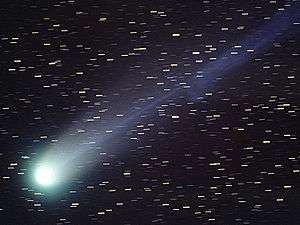Lincoln Near-Earth Asteroid Research
Coordinates: 33°49′05.3″N 106°39′33.0″W / 33.818139°N 106.659167°W

|
LINEAR NEAT Spacewatch LONEOS |
Catalina Sky Survey Pan-STARRS NEOWISE other |
The Lincoln Near-Earth Asteroid Research (LINEAR) project is a collaboration of the United States Air Force, NASA, and the MIT's Lincoln Laboratory for the systematic discovery and tracking of near-Earth asteroids. LINEAR was responsible for the majority of asteroid detections from 1998 until it was overtaken by the Catalina Sky Survey in 2005.[1] As of 15 September 2011, LINEAR had detected 231,082 new objects, of which at least 2,423 were near-Earth asteroids and 279 were comets.[2] The instruments used by the LINEAR program are located at the Lincoln Laboratory's site on the White Sands Missile Range (WSMR) near Socorro, New Mexico.
History
In the late 1970s, a prototype called the Lincoln Laboratory Experimental Test System (ETS) (MPC code 704) was built at WSMR.[3] The project used low-light video cameras.[4] In 1994 a new proposal was made for automated detection of asteroids, this time using newer digital detector technology.[5] The LINEAR project began operating a near-Earth object (NEO) discovery facility in 1996 using a 1.0 m (39 in) aperture telescope designed for the Air Force Space Command's Ground-based Electro-Optical Deep Space Surveillance (GEODSS). The wide-field Air Force telescopes were designed for optical observation of Earth-orbiting spacecraft. Initial field tests used a 1024 × 1024 pixel charge-coupled device (CCD) detector. While this CCD detector filled only about one fifth of the telescope's field of view, four near-earth objects were discovered. A 1960 × 2560 pixel CCD which covered the telescope's two-square degree field of view was then installed, and both detectors were used in later tests.[6]
The first LINEAR telescope became fully operational in March 1998.[7] Beginning in October 1999, a second 1.0 m telescope was added to the search effort.[8] In 2002, a 0.5 m (20 in) telescope equipped with the original CCD was brought on-line to provide follow-up observations for the discoveries made by the two search telescopes.[9] This allowed about 20% more of the sky to be searched each night. Data recorded by the telescopes is sent to a Lincoln Laboratory facility at Hanscom Air Force Base in Lexington, Massachusetts for processing. Detections are then forwarded to the Minor Planet Center.[2]
Discoveries
In addition to discovering hundreds of thousands of asteroids, LINEAR is also credited with the discovery, or co-discovery, or rediscovery of several periodic comets, including 11P/Tempel–Swift–LINEAR, 158P/Kowal-LINEAR, 160P/LINEAR (LINEAR 43), 165P/LINEAR (LINEAR 10), and 176P/LINEAR (LINEAR 52, 118401 LINEAR: one of only five objects classified both as comets and asteroids). Other objects discovered include (137108) 1999 AN10, (179806) 2002 TD66, and 2004 FH.
See also
References
- ↑ "NEO Discovery Statistics". NASA Near Earth Object Program. Retrieved 2012-01-19.
- 1 2 "MIT Lincoln Laboratory: LINEAR". MIT Lincoln Laboratory. Retrieved 2012-01-19.
- ↑ Beatty, D. E.; Sorvari, J. M.; Taff, L. G. (1980). "Artificial satellites, minor planets, and the ETS". Unknown 81: 12143. Bibcode:1980STIN...8112143B.
- ↑ Taff, L. G. (1981). "A new asteroid observation and search technique". Astronomical Society of the Pacific 93: 658. Bibcode:1981PASP...93..658T. doi:10.1086/130905.
- ↑ Tennyson, Peter D.; Rork, Eugene W.; Kostishack, Daniel F. (1994). "Proceedings of SPIE". Instrumentation in Astronomy VIII 2198: 1286. doi:10.1117/12.176813.
- ↑ "Lincoln Near-Earth Asteroid Research (LINEAR)". NASA Near Earth Object Program. Retrieved 2012-01-19.
- ↑ Stokes, G. H.; Viggh, H. E. M.; Shelly, F. L.; Blythe, M. S.; Stuart, J. S. (1998). "Results from the Lincoln Near Earth Asteroid Research (LINEAR) Project". American Astronomical Society 30: 1042. Bibcode:1998DPS....30.1607S.
- ↑ Elowitz, R. M.; Stokes, G. H.; Bezpalko, M.; Blythe, M. S.; Evans, J. B.; Pearce, E. C.; Sayer, R. W.; Shelly, F. C.; Viggh, H. E. M. (1999). "A Progress Report on the Lincoln Near Earth Asteroid Research Project". American Astronomical Society 195: 1531. Bibcode:1999AAS...19510801E.
- ↑ Stokes, G. H.; Evans, J. B.; Shelly, F. C. (2002). "LINEAR Search and Operations Experience". American Astronomical Society 201: 1315. Bibcode:2002AAS...20113003S.
External links
- Official website
- NEO discovery statistics from JPL. Shows the number of asteroids of various types (potentially hazardous, size >1 km, etc.) that different programs have discovered, by year.
- Sky Database for Objects in Time-Domain provides corrected LINEAR data.
| ||||||||||||||||||||||||||||||||


